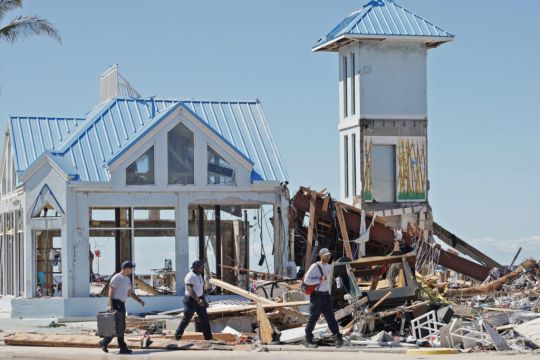US officials have pledged to provide an unprecedented amount of federal disaster aid as crews scrambled to rescue people still trapped by floodwaters from Hurricane Ian.
Days after Ian tore through central Florida, carving a deadly path of destruction into the Carolinas, water levels continued to rise in some flooded areas, inundating homes and streets that were passable just a day or two earlier.
The death toll continued to rise and hundreds of thousands of people were still without power in Florida and North and South Carolina.

Deanne Criswell, administrator of the Federal Emergency Management Agency, said the government was ready to help in a huge way, focusing first on victims in Florida, which took the brunt of one of the strongest storms to make landfall in the US.
President Joe Biden and first lady Jill Biden plan to visit the state on Wednesday.
Flooded roads and washed-out bridges to barrier islands left many people isolated amid limited mobile phone service and a lack of basic amenities such as water, electricity and the internet.
Officials warned that the situation in many areas is not expected to improve for several days because all the rain that fell has nowhere to go as waterways are overflowing.

Nearly 850,000 homes and businesses were still without electricity on Sunday, down from a peak of 2.67 million.
Ms Criswell said the federal government had started to arrange the “largest amount of search and rescue assets that I think we’ve ever put in place before” to supplement Florida’s resources.
“We worry a lot about the direct impacts from the storm itself as it is making landfall, but we see so many more injuries and sometimes more fatalities after the storm,” she said.
“People need to stay vigilant right now. Standing water brings with it all kinds of hazards — it has debris, it could have power lines, it could have hazards in there that you just don’t know about.”

At least 54 people have been confirmed dead – 47 in Florida, four in North Carolina and three in Cuba.
The weakened storm drifted north on Sunday and was expected to dump rain on parts of Virginia, West Virginia, Maryland and southern Pennsylvania, according to the National Hurricane Centre, which warned of the potential for flash-flooding.
More than 1,000 people have been rescued from flooded areas along Florida’s south-western coast alone, said Daniel Hokanson, a four-star general and head of the National Guard.
I spent time passing out food and water with the @FLGuard from one of our PODs in Lee County. We have PODs open to help those recovering from #HurricaneIan.
To find a POD near you, visit: https://t.co/Io8r6Bbog4 pic.twitter.com/EOPXJi2JKp— Ron DeSantis (@GovRonDeSantis) October 2, 2022
Florida governor Ron DeSantis said on Saturday that multibillionaire businessman Elon Musk was providing 120 Starlink satellites to “help bridge some of the communication issues”.
Starlink, a satellite-based internet system created by Mr Musk’s SpaceX, will provide high-speed connectivity.
The bridge to Pine Island, the largest barrier island off Florida’s Gulf Coast, was destroyed by the storm, leaving it accessible only by boat or air. Some flew out by helicopter.
An aerial photo of the Mad Hatter Restaurant on nearby Sanibel Island that was posted on social media shows a mostly vacant patch of sand where the restaurant used to be. The staff are safe, according to a message on the restaurant’s Facebook page.

Fort Myers mayor Kevin Anderson on Sunday defended Lee County officials from accusations that they had been slow in ordering evacuations on Tuesday ahead of the storm, a day later than some other counties in the area.
“Warnings for hurricane season start in June. So there’s a degree of personal responsibility here. I think the county acted appropriately. The thing is, a certain percentage of people will not heed the warnings regardless,” he said.
Elsewhere, power remained knocked out to at least half of South Carolina’s Pawleys Island, a beach community roughly 75 miles up the coast from Charleston.
In North Carolina, the storm downed trees and power lines. Two of the four deaths in the state were from storm-related vehicle crashes, and the others involved a man who drowned when his truck plunged into a swamp and another killed by carbon monoxide poisoning from a generator in a garage.







